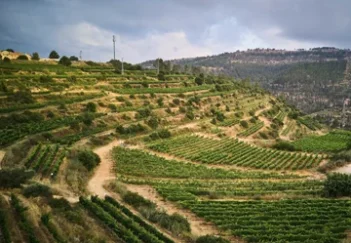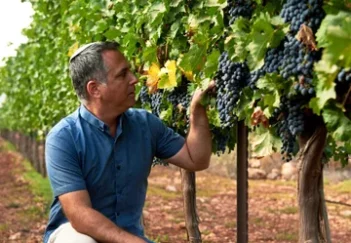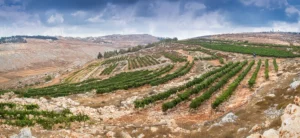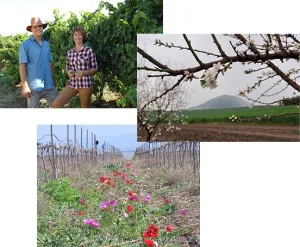It was not so long ago, that the less expensive wines in Israel were made from a long list of grape varieties, which were known overseas, but had a ghastly reputation here. I am thinking of dry wines made from Colombard (aka French Colombard), semi dry wines made from Semillon or Chenin Blanc, rosés made from Grenache, reds from Carignan and Petite Sirah, not forgetting sweet wines from Muscat.
These varieties came to symbolize the old Israel where whites were often yellowing and oxidized on the shelves. Wines that were meant to be semi dry were most likely semi sweet. As for the reds, they tended to be astringent and lacking fruit. There was barely a semblance of varietal character in any of them.
When the wine revolution started in the 1980’s, these were pretty much everywhere, but they were initially superseded by the likes of Sauvignon Blanc, Emerald Riesling, and Cabernet Sauvignon and they were later joined by Chardonnay, Gewurztraminer, Merlot and Shiraz.
As the new grape varieties took over, the older grape varieties became less fashionable. Wine lovers in Israel would shy away from them as if they alone were responsible for the bad old days.
Fast forward to the 2000’s and we now have enough Cabernet Sauvignon and Merlot planted so even the cheapest wines can be made with these varieties. With the new confidence gained from internationally trained winemakers making very good wines over a number of years, there has been a wonderful, praiseworthy trend of returning to the traditional varieties.
Looking at the same variety with new eyes, winemakers saw the potential to make a wine that is different to the new norm. Either by using older vines or by planting new clones, these varieties now symbolize something of interest to the wine lover and connoisseur. After all, who wants to drink Cabernet, Merlot and Chardonnay all the time
For example Carignan, the backbone of Israeli wine for 130 years and once a marker of mediocrity, was revived by Asaf Paz of Vitkin Winery using older vines and greatly reduced yields. Petite Sirah was given a place showing its quality and individuality by Lior Lacser at Carmel Winery.
A minerally single vineyard Semillon was launched by Naama Sorkin of Dalton Winery. Sam Soroka decided to harness the natural acidity and flowery aroma of Colombard by producing a great value, refreshing varietal wine at Mony Winery. Grenache is another returnee. The late and much missed Tzina Avidan of Avidan Winery and Uri Hetz of Chateau Golan were the pioneers, and this is a variety with a long way to go here.
Even the humble Muscat has been revived, because of the success of a different style of wine using Muscat grapes, called Moscato. It is all the rage. The pioneer was Victor Schoenfeld of the Golan Heights Winery with Golan Moscato from the Muscat Canneli grape. Now ‘Moscato Madness’ has arrived in Israel and versions can be found under brand names Buzz, Hermon, Selected and Teperberg.
However the latest arrival, or should I say returnee, is Chenin Blanc (pronounced Shenin). This variety will be remembered in the early 1990’s for producing semi dry wines, but it played a second fiddle to Emerald Riesling in those days. Emerald Riesling had no international pedigree, apart from dubious beginnings in California, whereas Chenin Blanc was well regarded, but trends are a funny thing. Emerald Riesling was not only the new thing in Israel, but the largest selling wine. Interest in Chenin Blanc fizzled out, and Chenin Blanc on the label became almost undesirable.
Chenin Blanc really reaches greatness in only one particular region, the Loire Valley in France. The main things to say in its favor are that the variety always has a very good acidity and it is incredibly versatile giving the winemaker many options. Along with the German Riesling, it makes wines of every style from bone dry to unctuous sweet and even sparkling. It is also used for fortified wines.
Unlike the Riesling, its calling card is not immediately obvious. In dry steely wines, talk will be notes of green apple and flint. Sometimes it will appear to be not so different from Sauvignon Blanc, but without the in your face aromatics. In light, semi-dry versions the description will trip to floral notes and riper versions in hotter climates will inevitably be more associated with tropical fruit. The great, luscious dessert wines will be rich honeyed wines with hints of honeysuckle, which will age for ever.
The most famous Chenin Blancs are Savennieres, which will always be dry; Vouvray, which cover the full spectrum from dry to sweet; Coteaux du Layon which are always sweet and Cremant de Loire, sparkling wines. All are from the Loire Valley.
In the New World and Israel, the Chenin Blanc is less distinguished. In South Africa though, it is the main white variety. There it is also known as Steen. It makes some very good wines as well as basic shelf fillers, but it never reaches the greatness that it achieves in the Loire.
In Israel, Chenin Blanc is experiencing a comeback precisely because of that much sought natural acidity. There are not many Israeli wineries making Chenin Blanc, but those that do illustrate a broad range of wines, but there is no one style which shouts out Chenin Blanc.
Zeev Dunie of the Sea Horse Winery is the pioneer of Chenin Blanc, being the first to return to using it. He calls his Chenin Blanc ‘James’ in memory of Ronnie James of Tzora Vineyards where he and so many others were first enthused about winemaking.
Shvo Vineyards is owned by Gaby Sadan, one of Israel’s finest winemakers. When he chose to plant Chenin Blanc in his start up Upper Galilee vineyard, people took notice. This alone was enough for many to take another look at the variety.
Pierre Miodownik has chosen Mediterranean varieties and Chenin Blanc as the varieties for his Domaine Netofa winery. No Cabernet, Merlot or Chardonnay for him! He makes two Chenin Blancs.
Assaf Kedem spent time in South Africa and what he learnt there influences him to this day. His Assaf Winery is at Kidmat Zvi on the Golan Heights. He produces a Chenin Blanc to pay homage to the Steen wines he came know well from there.
Tal Pelter is one of Israel’s most celebrated winemakers. However, Pelter Winery, situated on the Golan Heights, is not kosher. So he has founded a new winery called Matar by Pelter, which is kosher. The wines have stylish labels and the Chenin Blanc may be recognized by its unusual and attractive powder blue capsule.
So Chenin is back! We are following its second coming very carefully and with great interest.
The main Israeli Chenin Blancs are as follows:
Sea Horse James 2013 (NK)
This comes from an old vine vineyard in the Judean Plain (Gedera to be exact), which is in the Samson Wine Region. The wine is barrel fermented and aged. The result is a fragrant wine with notes of peach and pear wrapped in a sweetish texture (though it is a dry wine), with a clear acidity which comes to light in the finish. Certainly not an obvious Chenin Blanc, but a great wine nonetheless.
Shvo Chenin Blanc 2011
This wine has an understated nose of greengage and nectarine, slightly grassy in the background, with rippling minerality and a delicate herbaceous character on the palate and a long balanced finish.
Netofa White 2014
The unoaked 2014 is crisp, with delicate tropical fruit notes and good acidity from a Lower Galilee vineyard. It is truly refreshing and a great summer wine.
Netofa Latour White 2013
is part oak aged giving more complexity and broadness in the mouth. Out of the two I preferred the purer, simpler version.
Assaf Chenin Blanc 2013 (NK)
The Assaf Chenin Blanc 2013 is in a more blowsy style. It has an attractive flowery nose, prominent acidity and a slight bitterness on the finish, which gives it a refreshing quality.
Matar Chenin Blanc 2013
is very dry, with pronounced acidity, with more green apple than any soft fruit influences. It is lean and refreshing. It comes from Mitzpe Ramon in the deepest Negev.



















